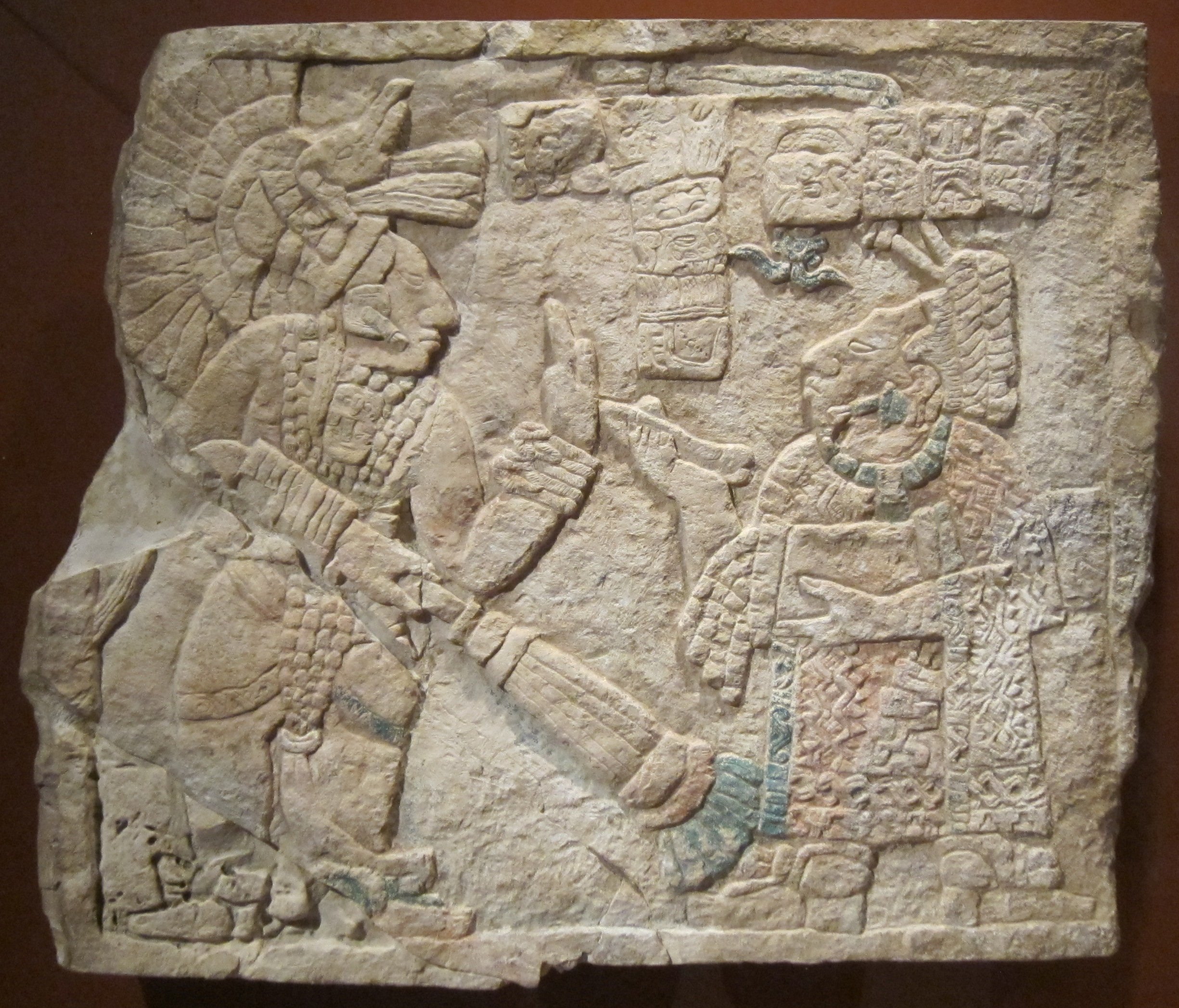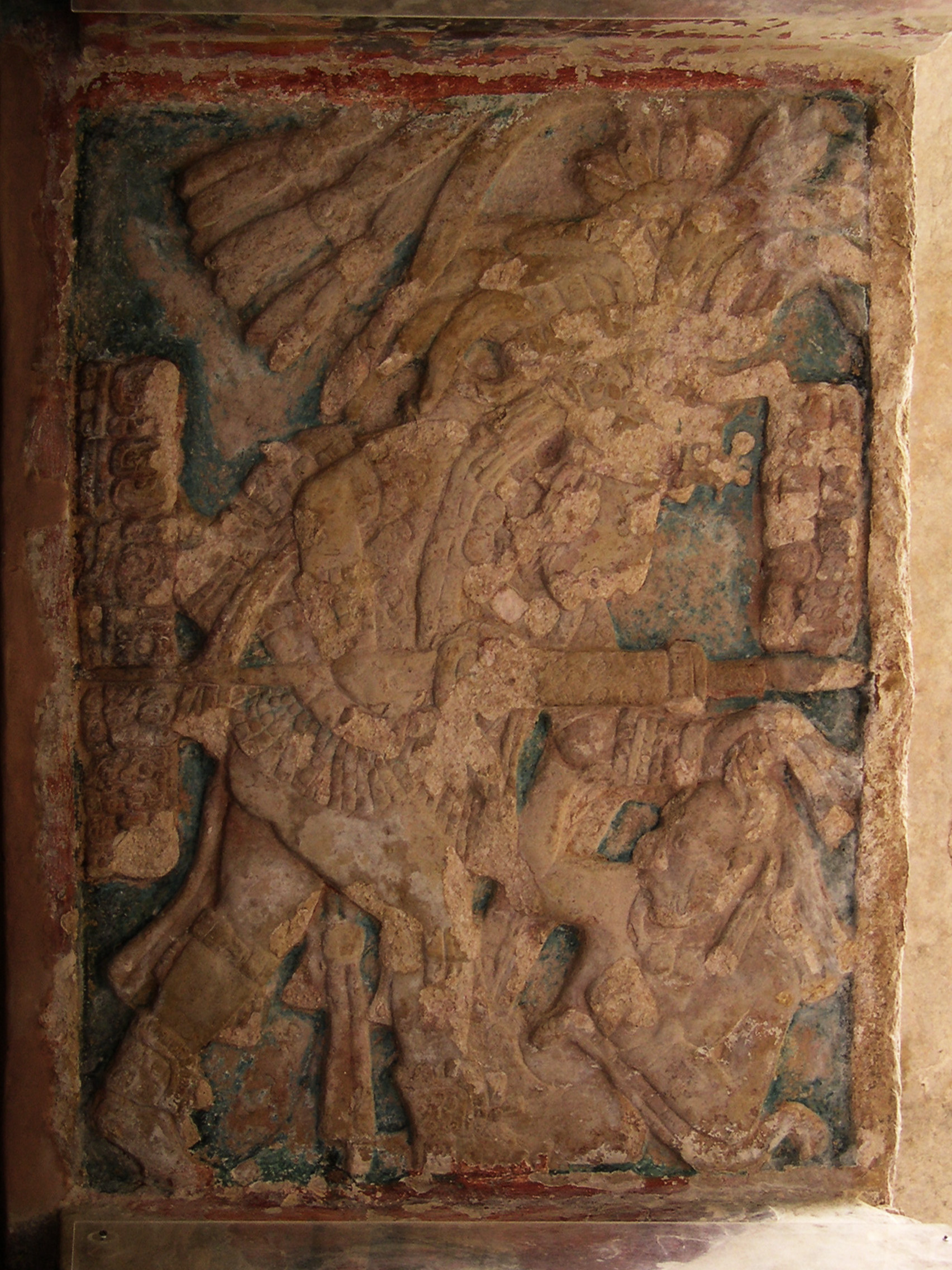Reading/living myth: a dance with time (for Olimpia)
Artist and poet Genevieve DeLeon reads The Popol Vuh on the Metro, superimposing Mayan mythology and present-day human figures to consider the twinning of art and life, the living and the dead, language and image, gesture and meaning.

Here we will gather what can be shown,
here we will gather what can be made known,
the account of the first sowing and the first dawn
brought by the Framer and the Shaper…2
Walking down a city street after reading The Popol Vuh produces a strange vision. Shot through with lightning, everyone who advances, everyone who retreats, passes through a mythic x-ray. I behold passers-by in narrativized, pictorial space. Cast as primeval archetypes, they play in a drama that unfolds in real time.
The Framer appears first. Lean, in white sneakers with dark pants, they bolt down the sidewalk in a flurry.
The Shaper, next, deep in thought. In a 70s-style jacket, they are taken aback when I pass them on the escalator into the train station.
Entering a Metro car, over-stuffed with holiday rush,
A Hero Twin breaks into a smile. She is dressed in gym clothes, flashing teeth, giddy from the music playing on her headphones. The other, by her side, tucks her hair behind her ear. They are sisters enjoying the time off from school.
Originally written in K’iche’ between 1554 and 1558, The Popol Vuh is a Maya document famous for encoding ancient Mayan mythology and culture. It details the origin of humankind, the lives of the gods, and the history of the K’iche’ people.3 To read myth is to encounter art once posited as truth. No matter its date of conception, its claim on veracity registers, for me, in the present, amplifying a dramatic impulse, foregrounding the archetypal over “the real.”
Belonging to a genre of fluctuating status within literary circles, this mythological text is rendered even more questionable in my hands. Since becoming a teacher, I read quickly and retain little. Written words enter a mind overspun with content from classes crafted as they are taught. But on winter break, book in hand, I make a trip downtown to think. Between cities, careers, decades, this text has become a talisman for heavy transitions.
The preamble begins: The root of the ancient word starts here. Simple and assured, it lists the creators “named and known”: it was Grandmother and Grandfather, Xmucane and Xpiyacoc, who
…spoke the world into being / with luminous words and clear truth.4
I mouth the words clear and truth with longing for a framework in which lucidity might redress confusion. But I am heartened, at least, by the conviction that speaking creates. In the Metro car, there is endless chatter at my back, at my sides. Whiling away hours with talk is a hallmark of holidays at home.
Each section of The Popol Vuh is its own conversation. Like banter circling the dinner table, every story, thread, theme, subtheme, iterates a new path through a narrative field intended to circumscribe our origin. Hardly linear, the work fractures and is fractal; it seeds and germinates.
Each story’s closing is troubled and unsettled. Its circularity operates in dissonance with the day-to-day experience of hard deadlines and fixed boundaries: years divided into semesters, rail cars shuffling across district lines, demarcations whose endings are too abrupt to process. Myth upsets time as it reframes truth. Its gift: to soften the shock of finality, to reopen foregone conclusions.
Seeking humble entrance into the Mayan imaginary, I began studying Mayan hieroglyphs six months ago. An alphabet with eyes, Mayan hieroglyphs operate as much as a figurative tradition as they do a script. Ancestors seem to push against the page from the other side. I imagine my grandfather, part Mayan, long dead, watchful as I study. He peers through the eyes of the figure-glyphs I copy. It is his mythic vision, I imagine, that projects outward as I read The Popol Vuh.
“We now know that the ancient Maya scribes had tremendous latitude for visual creativity. Their system had strict rules, but each time they wrote a given word or phrase, they could choose from a variety of signs and combine them in new ways.
They arranged their signs in double columns and read them left to right and top to bottom. In their earliest transcriptions, they made each glyph a single sign. Soon, they began to combine half a dozen or more signs in a single glyph block. But the graphic complexity of their system went even further.
A sign could be written in abstract form, or as a head of a god, one sign could be tucked inside another, or hidden part way behind another. Two signs could fuse together, merging their attributes. Signs even included full figures of monsters and gods.”5
It’s no surprise, then, when first reading The Popol Vuh, that the characters form as hieroglyphs in my mind’s eye; I link Xmucane and Xpiyacoc, the Seven Macaw and Zipacna, and the Hero Twins, in pairs, stacking them in columns. Once arranged, they disarray: shuffle, combine, and condense. Signs yield blocks; blocks, scenes; scenes, tales.
Also watchful from the other side of the page: Olimpia. Recently deceased, she is a dear friend lost too early to cancer. Here, in the space of myth, she breathes. She actively inserts into story, her presence fusing, merging, tucking inside that of my grandfather. I feel her in the room as I read. This would discomfort some. I send her mother, Amalia, a photo: a drawing I have made of two women from Quiché, bent forward, lurching at the head of a procession, leading the way with large ceremonial candles. Olimpia is as alive as any drawing, as true as any myth to its reader. Art and life twin as the living and dead do. Can this make sense? Grief makes you half-crazy and a bore.
The density of all this casts me further down the Red Line. The increasing anonymity of the city helps me consider how bodies are never not mid-pose or mid-gesture. To carry our body at all (to be carried by it) is to choreograph meaning.
I imagine the Mayan glyphs feel the forms they take, the syntax they assume. They are cramped and comforted by the constraints of the system in which they appear.
In the Metro car, seated, two by two, patrons of public transportation compose a tableau vivant of archetypes, hieroglyphs, strangers. Gods in plainclothes shift identification easily: at each stop, signs lift out of their seats, switch place. As other signs leave, new signs enter. The architecture of the Metro car, the intervals of its stops, composes an ancient script, written and rewritten.
Now,
The lighting of the sky
and the germination of the earth
takes a while to perform:
its four corners and four sides,
the measuring and staking,
the halving and the stretching
of those cords that contain
the womb of sky and earth.
So the four corners and four sides
were laid out, as it is said,
by the Framer and the Shaper,
mother-father of life and birth,
giver of breath, giver of heart,
those who bear the never-ending light,
those who hearten the sunlit children
born of woman and man;
they are tender in all things,
the Framer and the Shaper,
they are knowers of all things,
all that there is in sky and earth and lake and sea.8
There is obvious music to this translation which has shifted across tongues and cultures. It sang differently in its own time, and yet in motion, it rolls along, retains an urgency. Its rhythm buoys me; its words foster a space of suspension without which I would seek more desperate escape.
Bodies are never not mid-pose or mid-gesture. They are also texts which communicate across divides. Even when still, even when stone, they assume a form which implies movement. I remember her body, arms at her sides, tucked in at home. Her eyes peering out, inquisitive and bare, she spoke to her mother in sounds and glances they both understood. She spoke to me, too: once drawing a hand slowly up from her abdomen to her heart. Bedridden, her body was framed and shaped by the architecture around it. Her body signed tenderness.
Even in this manner, her speaking created: I curled my body forward in a gentle arch I hoped she could interpret. Even asleep, her body continued its talking.

Our dialogue continues: in dreams, when I read. I make of this what I can. Having arrived downtown, I see a young woman who looks just like her: a different kind of mythic vision. Mistaken, but the sense of her it conjures is real; I entreat this stranger to play out her role for longer. Bodies are never not mid-pose or mid-gesture: we always read the real for our own ends. I pull up a chair to a cafe window, enter a time and truth in which we can meet.
This article is part of the series by guest editor Kristin Van Loon.